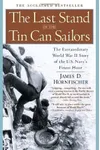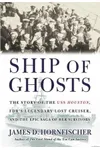Picture a storyteller who spun tales of courage and sacrifice on the high seas—meet James D. Hornfischer! This Austin-based naval historian brought the Pacific War of World War II to life with gripping narratives that feel like epic adventures. Known for his meticulous research and vivid prose, Hornfischer’s books, like The Last Stand of the Tin Can Sailors, are must-reads at the U.S. Naval War College, cementing his legacy as a master of naval history.
With a knack for turning dusty archives into page-turners, Hornfischer didn’t just write history—he made it pulse with the heartbeats of sailors and marines. His work captures the drama of battles and the human spirit behind them, earning him accolades and a devoted following. Let’s dive into the life and legacy of this remarkable author!
The Making of James D. Hornfischer
Born on November 18, 1965, in Salem, Massachusetts, James D. Hornfischer grew up with a fascination for military history. As a kid, he pored over library books in the 940.54 Dewey Decimal section, built model ships, and soaked up World War II tales from shows like The World at War. A Phi Beta Kappa graduate of Colgate University with high honors in German, he later earned an MBA and a Juris Doctor from the University of Texas. Before becoming a full-time author, he worked as a book editor at HarperCollins and founded Hornfischer Literary Management in Austin, mentoring aspiring writers.
His childhood love for naval history never faded. Canoeing under starry skies, young Jim imagined Pacific War campaigns like Guadalcanal. This passion drove him to become a historian who could make history feel as thrilling as a blockbuster movie.
James D. Hornfischer’s Unforgettable Stories
Hornfischer’s books are a deep dive into the Pacific Theater, blending exhaustive research with storytelling that grips you like a novel. His debut, The Last Stand of the Tin Can Sailors (2004), chronicles the Battle off Samar, where small U.S. Navy ships faced a massive Japanese fleet. It’s a tale of underdog heroism that won the Samuel Eliot Morison Award and landed on the New York Times bestseller list.
Ship of Ghosts (2006) follows the USS Houston, FDR’s favorite cruiser, and its crew’s harrowing survival in Japanese POW camps. Neptune’s Inferno (2011) tackles the brutal Guadalcanal campaign, earning praise for its clarity and emotional depth. His final major work, The Fleet at Flood Tide (2016), covers the 1944–1945 Pacific campaign, from Saipan to the atomic bombings, and snagged the Commodore John Barry Book Award. Hornfischer’s style—cinematic yet precise—makes you feel the spray of the sea and the weight of every decision.
He also co-authored Service: A Navy SEAL at War (2012) with Marcus Luttrell, showing his versatility. His books, required reading for naval officers, blend strategic insight with personal stories, making history accessible and unforgettable.
Why James D. Hornfischer Matters
Hornfischer’s impact goes beyond bookshelves. He brought the Pacific War’s unsung heroes to light, ensuring their sacrifices resonate with new generations. His lectures at the U.S. Naval Academy and National WWII Museum, along with appearances on C-SPAN and Fox News, made him a trusted voice in naval history. Reviewers called him the “dean of World War II naval history,” comparing him to Stephen Ambrose for his ability to popularize a lesser-known theater of war.
Despite his battle with glioblastoma, which claimed his life on June 2, 2021, at age 55, Hornfischer kept writing. His posthumous work, Who Can Hold the Sea, continues his legacy. His books remain a bridge to the past, inspiring readers to honor the courage of those who fought.
- Born: November 18, 1965, Salem, Massachusetts
- Key Works: The Last Stand of the Tin Can Sailors, Neptune’s Inferno, The Fleet at Flood Tide
- Awards: Samuel Eliot Morison Award, Commodore John Barry Book Award, Navy Distinguished Public Service Award
- Died: June 2, 2021, Austin, Texas
Snag The Last Stand of the Tin Can Sailors and dive into James D. Hornfischer’s thrilling naval histories! His stories of bravery will leave you in awe of the sailors who shaped history.









